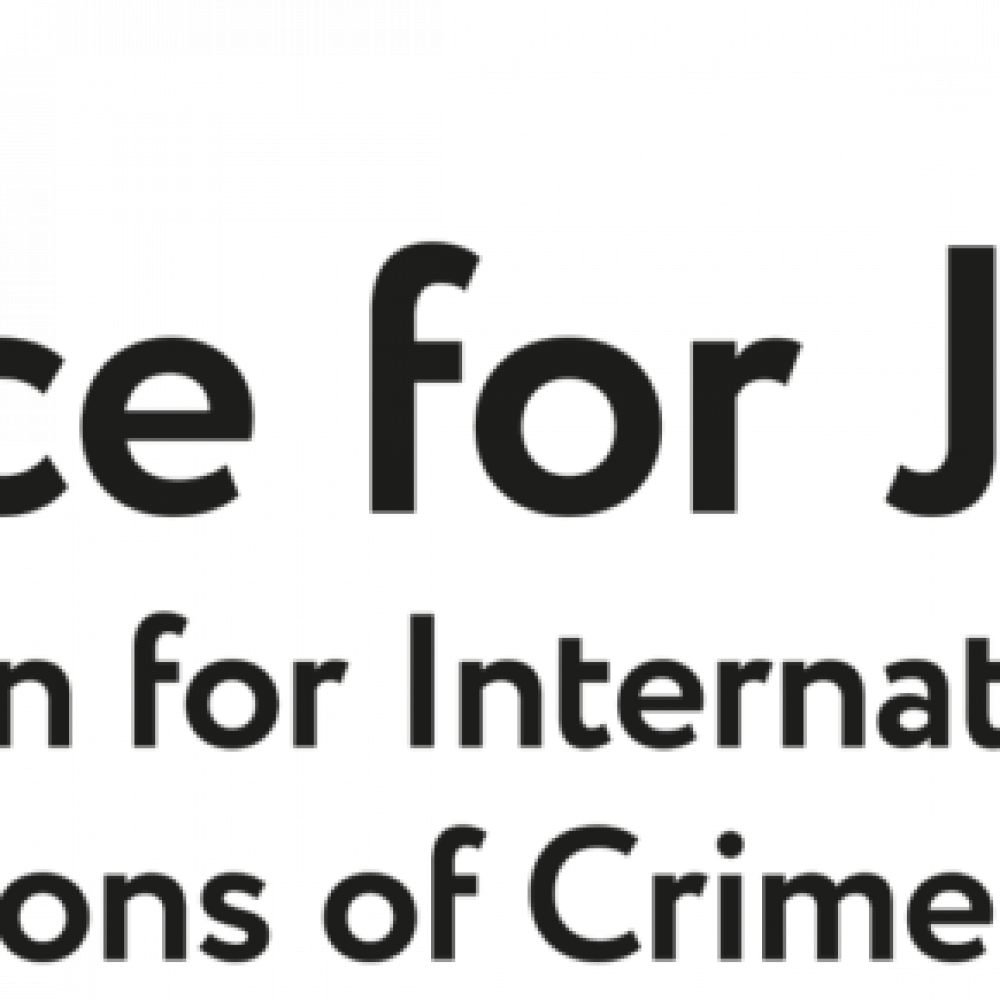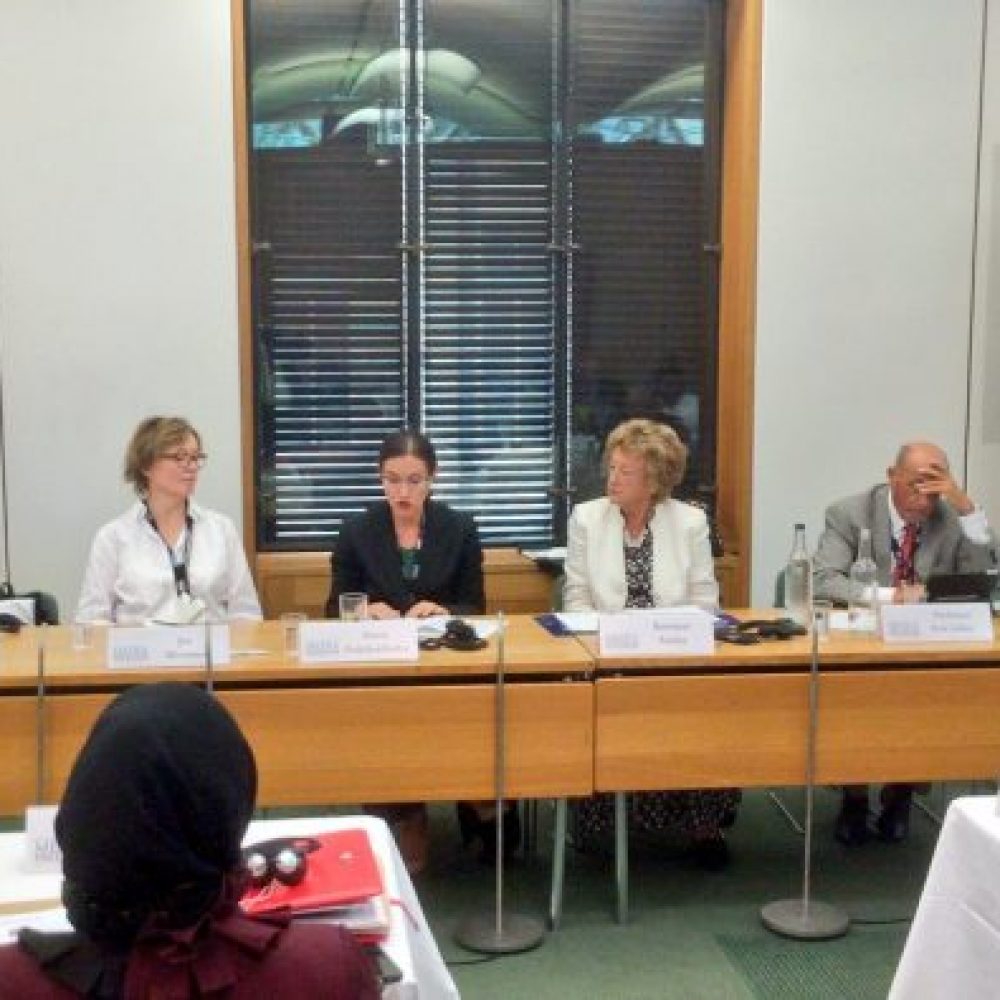Today, Maria Ordzhonikidze, trustee of the Justice for Journalists Foundation was a speaker on the International parliamentary seminar on Media Freedom on the panel dedicated to the International Frameworks on Protecting Journalists.
Other speakers included: Professor Ivor Gaber, Professor of Political Journalism, Sussex University and Joy Hyvarinen, Head of Advocacy, Index on Censorship. The Chair of the session was Baroness Anelay of St Johns, Chair of International Relations Committee.
The session provided an overview of the existing responsibilities and obligations imposed on states to maintain media freedom and protect journalists. It has also covered the challenges faced when implementing the international legislation and opened a discussion about how parliamentarians can work with government partners and other stakeholders to make these international mechanisms more effective.
During the session Ms. Ordzhonikidze has covered 4 main aspects:
- How and why the international laws to protect journalists are implemented or ignored in some of the countries.
- The international legal framework for the protection of journalists globally.
- Cases of different countries with murders, violent crimes and non-physical harassment against media workers, in particular how the states use or, in many cases, abuse the laws in dealing with those.
- A legal limbo, which is when a crime against a media worker is committed in foreign territory. The impunity in such cases is almost 100%.
Read the full speech:
The audience will be well aware that freedom of opinion and expression are enshrined in international human rights law and other international legislation. These rights are guaranteed by the European Convention of Human Rights (Article 19), the Charter of Fundamental Rights of the European Union and the International Covenant on Civil and Political Rights. In addition, Article 2 of the ECHR guarantees the right to life.
Guaranteeing journalists’ rights to carry out work in safe conditions, free from fear of being harassed, attacked, beaten or killed, forms the basis of the freedom of speech, one of the corner stones of democracy. Therefore, any attack against a media worker – whether physical, cyber, or psychological – is a direct attack on democracy itself and violates the public’s right to know.
Violence aimed at silencing journalists can take many forms and it is the responsibility of those states, who are signatories of these Conventions and Charters, to guarantee journalists’ safety, and to uphold and foster media freedom. And for these responsibilities to be met, governments themselves need to be more open and tolerant to dissents, critics, and even to investigations into their own dealings. Yet, as we all know, even out of the OSCE’s 57 members, many states can be said to merely imitate democracy.
It is the lack of independent institutions that explains why in those pseudo democratic countries most perpetrators have never been brought to justice. For the 1350 murders of media workers committed since 1992, the rate of impunity lies at 90%. It is important to understand that this number has nothing to do with the competence and training of law enforcement bodies and judiciaries. Unfortunately, very often it is the leaders of those de facto authoritarian regimes who are the most willing to hide the truth.
And this brings me to the second point of my presentation, which is that today more reporters are being killed or attacked for covering their communities, cities and countries, than for reporting on and from armed conflict zones. Corruption, populism, financial crimes and the diminishing accountability of authorities have created numerous other challenges and risks for both paid and unpaid journalists.
According to the Platform for the Protection of Safety of Journalists, in 60% of cases, the biggest risk faced by media workers in Council of Europe member state countries comes from state actors, rather than typical gangsters or terrorists.
Our own Expert survey of over 100 media workers from 12 post-Soviet countries shows a similar situation. Out of all Threats, our respondents listed their Top-5 as:
- Prosecution by the authorities
- Cyber-attacks and threats
- Hacking
- Physical attacks
- Harassment using quasi-legal mechanisms
It is also important to mention that when asked to specify the main Physical threats that face them, our respondents listed Pressure from the authorities, such as surveillance, detention, interrogation, arrest, and judicial prosecution, above actual physical violence from the police.
This is confirmed by our preliminary open source analysis, which has shown that in countries like Russia and Azerbaijan, harassment by authorities has been by far the leading crime against media workers. At the same time, in Ukraine, cyber- and non-physical harassment by other actors leads.
So, while publicly declaring their accord to international legislation and principles about protecting media freedom and the safety of journalists, some governments choose to distort their domestic legal framework and abuse their executive power to silence independent media.
Among quasi-legal ways of silencing the journalists are defamation and libel lawsuits, accusations in enflaming ethnic and social tensions, the seizure of personal and professional records in the name of national security or direct pressure from government officials, etc.
Terrorism and extremism are increasingly used as a pretext to curb free speech by non-democratic governments. For example, the recent laws on censorship almost simultaneously introduced in countries like Russia and Egypt (a combined population of almost a quarter of a billion people) now enable media regulators to block any media without court orders if they suspect the reporting is “fake news” or “dangerous for national security”.
According to RSF statistics, over 300 of media workers imprisoned today, with Saudi Arabia, Vietnam, Egypt and China leading the list. Turkey has the worst record among Council of Europe member states, with at least 110 journalists in prison.
According to Russia’s independent human rights monitoring service OVD-info, 32 media workers were detained during just two days of protests against the rigged city duma elections in Moscow.
All these mechanisms, along with murders, kidnappings and physical attacks, are being exercised more and more often against journalists to force them to censor their work out of fear of the consequences.
It’s no wonder the level of impunity in such countries remains very high. We in the Foundation strongly believe there needs to be a comprehensive global monitoring mechanism and wider awareness of the cunning ways through which authoritarian and kleptocratic governments abuse their power and stifle justice.
Which brings me to the third point of my presentation today, and that is about cases of utter and complete legal limbo when journalists are murdered in foreign countries.
I will outline two very similar cases, the first of which I mentioned earlier. In July 2018, Orkhan Dzhemal, Alexander Rastorguev and Kirill Radchenko were brutally murdered in CAR while collecting material for a documentary about the Wagner private mercenary group. The official joint investigation by Russian and CAR has brought zero results. Perhaps this can be partly explained by intergovernmental agreement between the RF and the CAR on military cooperation, the supply of weapons, the provision of Russian military instructors and the establishing of a representative office of the Russian Ministry of Defence in the CAR. This agreement also envisages “direct interaction of law enforcement bodies and cooperation in criminal and other cases”. The UN is only able to launch an investigation, should one of the countries or a CAR Judges request it to do so. Neither of these scenarios is likely.
A year before that, in August 2017, 26-year old freelancer Christopher Allen was killed whilst reporting on civil war in South Sudan. Immediately after his death, pictures of Chris’ stripped, wounded and lifeless body appeared across the internet in what was perceived as a propaganda instrument and a warning not to pursue justice for the killing. Little support has come from the US and virtually none from the UK, Chris’ two countries of nationality. There has been no official investigation so far.
As with the widely publicised case of Daphne Caruana Galizia, the murder investigation is being brushed under the carpet by the national government. It seems very unlikely that the UN investigation mechanism will be activated. At the moment, the only way to fight impunity in such cases is via independent journalistic investigations and large-scale international advocacy campaigns by our esteemed colleagues.
And of course, I need to finish my rather gloomy speech today with something more optimistic.
Here are just a few observations and ideas on what works and what else can be done on national, international, and civil society levels.
1) On the state level in countries with working democratic institutions and real division of powers:
Italy: There have been 3317 cases of threats, including violent ones, against journalists in the last 10 years. The media profession in Italy is being discredited from the top down, and is seen as something that needs to be got rid of. Criminal groups are being shielded by political institutions. But in comparison to the situation in Russia, Central Asia and Turkey the profession is fortunate to have protection from criminal and fascist groups. 22 journalists in Italy live under police protection.
France: The case of Charlie Hebdo demonstrates that a media outlet, which had paid the ultimate price for expressing its opinions and beliefs, was able to recover and continue operating. It is fortunate for Charlie Hebdo that there exists protection from democratic institutions. This is not the case for outlets operating under authoritarian regimes. With the help of police protection, Charlie Hebdo can continue to express its views and defend freedom of speech.
(Of course, in countries like Montenegro and Serbia so-called police protection actually prevents journalists from publishing their investigations)
2) On the international level:
The CoE reporting mechanism mentioned above works, but only in the countries that care about their image as democracies. In Slovakia the investigation of Jan Kuciak case was conducted very efficiently, the murderers were found, and Prime Minister Fico and his entire cabinet had to resign. Countries with kleptocratic governments, like Malta, won’t budge. This is same in authoritarian nations like Turkey, Russia, Azerbaijan and others. As we watch how at the national level the situation is deteriorating, we must accept that current international treaties, conventions and monitoring mechanisms do not suffice.
There need to be ways of making it costlier for governments to misbehave in relation to safety of journalists. What can be done to enhance this mechanism? Personal sanctions? Or perhaps something similar to the Magnitsky Act?
3) On a civil society level:
To compliment the efforts of our esteemed colleagues at RSF, CPJ, Index of Censorship, Rory Peck Trust, Frontline Register, Article 19 and others, we are working on developing a system of Incident reporting. This will open the way for information exchange among the previously neglected post-Soviet countries. The foundation is also developing a Risk Map for this region, as well as a tailor-made safety training programme for media workers on the basis of this information.
But of course, what we are lacking is a working legal mechanism to investigate and punish crimes against journalists at the international level, when more than one country is involved. We also need to find a way to fight impunity when crimes against journalists are committed in third countries.
Thank you for your time.

